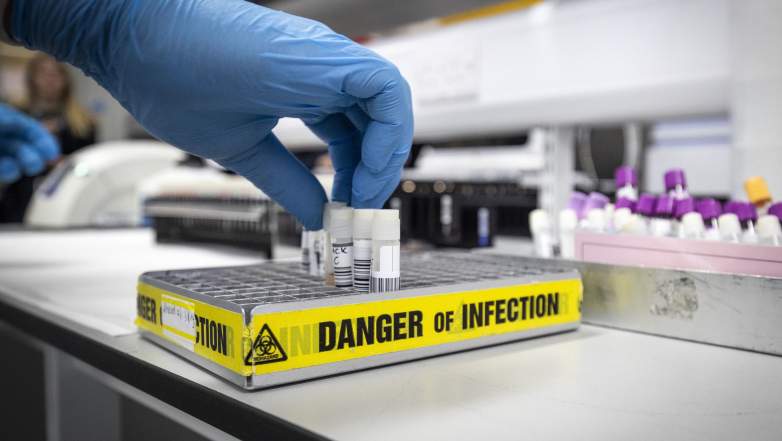
Getty Coronavirus continues to spread in the U.S.
The Centers for Disease Control and Prevention (CDC) has issued new COVID-19 suggestions for universities and colleges as higher education institutions brace for a return to campus in the fall semester. However, although the CDC details strategies for testing, it is not recommending that universities and college test all students and faculty.
“Testing of all students, faculty and staff for COVID-19 before allowing campus entry (entry testing) has not been systematically studied,” CDC wrote. “It is unknown if entry testing in IHEs (Institutions of Higher Education) provides any additional reduction in person-to-person transmission of the virus beyond what would be expected with implementation of other infection preventive measures (e.g., social distancing, cloth face covering, hand washing, enhanced cleaning and disinfection). Therefore, CDC does not recommend entry testing of all returning students, faculty, and staff.”
The CDC said that institutions considering such a broad testing policy should consider some issues with it, including, “Limited usefulness of a single administration of testing. Single administration could miss cases in the early stages of infection or subsequent exposures resulting in transmission, and would only provide COVID-19 status for individuals at that specific point in time.”
As of July 1, 2020, the CDC was reporting 2,624,873 cases of coronavirus in the United States, with 43,644 new cases, and 127,299 deaths.

CDC
The new CDC guidance was issued on June 30, 2020. Formally, the document is called, “Interim Considerations for Institutions of Higher Education Administrators for SARS-CoV-2 Testing.” The guidance comes as coronavirus cases have spiked in some cases throughout the United States.
“As some institutions of higher education (IHEs) open in the United States, CDC offers considerations for ways in which IHEs can help protect students, faculty, and staff and slow the spread of the coronavirus disease 2019 (COVID-19),” the CDC wrote. “Testing to diagnose COVID-19 is one component of a comprehensive strategy and should be used in conjunction with promoting behaviors that reduce spread, maintaining healthy environments, maintaining healthy operations, and preparing for when someone gets sick.”
Here’s what you need to know:
The CDC Says Broader Testing Might Be a Good Idea in Some Campus Settings

GettyClinical support technician Douglas Condie extracts viruses from swab samples so that the genetic structure of a virus can be analyzed and identified in the coronavirus testing laboratory at Glasgow Royal Infirmary.
The CDC outlines different testing strategies for COVID-19, but also explains some of the shortcomings, writing,
One strategy to identify individuals with COVID-19 signs or symptoms is to conduct daily symptom screening such as temperature screening and/or symptom checking for students, faculty, and staff. These screenings are one of many strategies IHEs can use to help lower the risk of COVID-19 transmission. However, because symptom screenings are not helpful for identification of individuals with COVID-19 who may be asymptomatic or pre-symptomatic, symptom screening alone will not prevent all individuals with COVID-19 from entering the IHE.
When it comes to symptomatic people, IHE administrators and healthcare providers “should immediately separate students, faculty, or staff with COVID-19 symptoms by providing distance learning options, isolation rooms in dormitories or other housing facilities, and providing alternative food service arrangements for those who live on campus,” says CDC, which also recommends testing “for all close contacts of persons diagnosed with COVID-19.”
Broader testing is recommend in some settings, such as “residence halls, laboratory facilities, and lecture rooms” that “may be settings with the potential for rapid and pervasive spread of SARS-CoV-2.”
The CDC says testing strategies should be determined with local officials and could vary depending on the size of an institution. “Implementation should be guided by what is feasible, practical, and acceptable, as well as tailored to the needs of each community,” CDC wrote.
“IHEs (Institutions of Higher Education) vary considerably in geographic location, size, and structure. As such, IHE officials should determine, in collaboration with state and local health officials, whether to implement any testing strategy, and if so, how to best do so.”
CDC advised, “Screening, testing, and contact tracing are actions that can be taken to slow and stop the spread of COVID-19. These strategies must be carried out in a way that protects individuals’ privacy and confidentiality and is consistent with applicable laws and regulations.”
When should someone be tested?
“Consistent with CDC’s recommendations, individuals with COVID-19 signs or symptoms should be referred to a healthcare provider for evaluation on whether testing is needed,” CDC wrote. “In some locations, individuals can also visit their state or local health department’s website to look for the latest local information on testing.”
READ NEXT: Kristy Ann Wilker: Fort Wayne, Indiana, Nurse Fired Over George Floyd Rant
